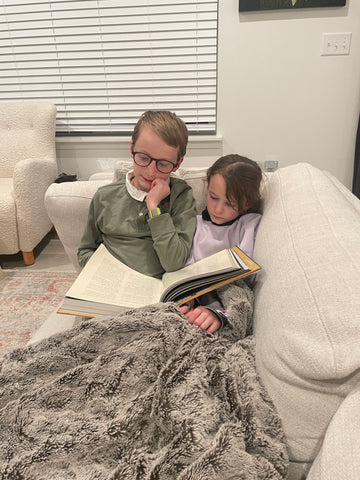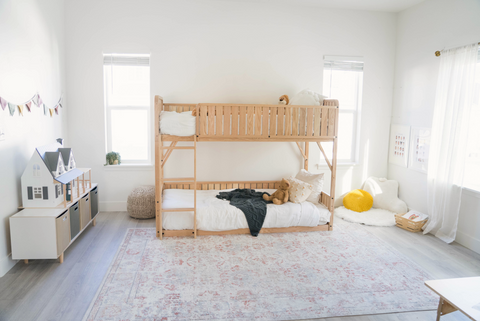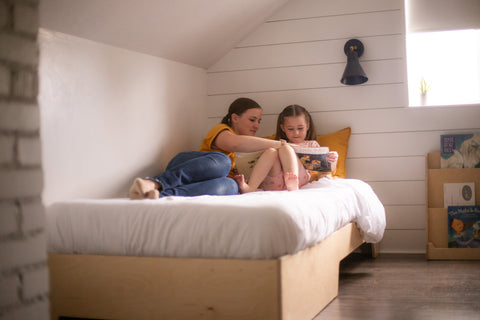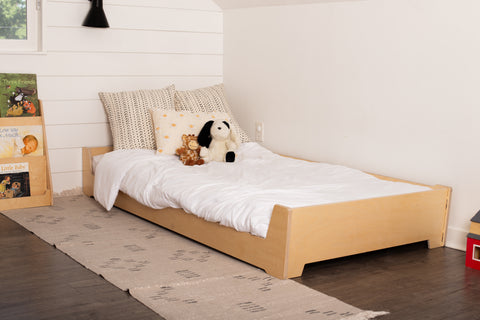
Sibling Room Sharing Tips & Strategies
Sibling Room Sharing Tips & Strategies
If you're contemplating or struggling with room sharing, know that you aren't alone! There is a lot to juggle and consider with this arrangement.
Jump To:
- Room Sharing 101
- Pros and Cons of Shared Bedrooms
- Establishing Rules and Routines
- Design Tips for Shared Bedrooms
- Common Questions, Challenges, and Concerns
- Room Sharing: You Can Do This!
When we asked our community about their shared bedroom concerns, here is what we heard:
“I’m so scared! How???”
“How do you get them to stop playing and go to sleep?”
"Is room sharing good for siblings?"
“Tonight was our first night and it was a disaster. Any tips??”
“How do you ensure each child maintains some independence or privacy as needed?”
“What if the two children are on different routines or schedules?”
“What is the best age to start room sharing?”
“Should we provide doubles of things, or is anything in the room shared? It’s already a small room!”
Room Sharing 101
While the idea of room sharing might feel daunting and overwhelming, it IS possible! One key part of room sharing is preparing the space to set everyone, children and parents alike, up for success. When a space is well-thought-out, it becomes functional and welcoming, which is important when helping a child feel comfortable.
While this can be a difficult transition for some, it can help to remember that you are trying to do what is best for your family and your space.
When I was in college I was a single parent and my two children and I lived in a small apartment. They shared a bedroom out of necessity, not choice. I hung a picture on the wall to try to remind us (aka me) that this was an opportunity. The sign said 'Love grows best in little houses, with fewer walls to separate. Where you eat and sleep so close together, you can't help but communicate.' Despite the initial circumstances of sharing a bedroom out of necessity, I am now reaping the benefits of the time we all spent so close together. While tuck-ins took longer, fights were had, personal items were taken, and there were some less-than-restful nights, I now think of that extra effort as an investment. Living in close quarters allowed them to develop a deep bond and sense of companionship that might not have flourished otherwise. While we have since moved and they each have their own bedrooms now, they are still each other's best friends.


Then and now
Pros and Cons of Shared Bedrooms
Many parents grapple with various questions, concerns, and hopes when it comes to their children sharing a room. These are some of the common ones:
Benefits of shared bedrooms- Building sibling relationships
- Inviting opportunities for connection with space for togetherness
- Maximizing space efficiency
- Personal space and privacy concerns
- Differing personalities and preferences
- Different sleep schedules
Establishing Rules and Routines
Setting boundaries for personal space:
Shared rooms can present unique challenges for children when it comes to personal space. There are a few ideas below for personalizing the space, but finding small ways to help children feel ownership can give them a sense of control. Additionally, it might help to set rules about not climbing into each others' sleep space, or waking the other sibling up before they are ready.
Encouraging open communication: This can be a great time to help children practice open communication and respectfully address conflict. When problems arise, it is important to give your child the appropriate language and responses to learn how to resolve conflict in healthy ways.
Establishing a cleaning routine: With two children in one room, spaces can get messy quite quickly. You can establish a rule that encourages them to clean up together after playtime or activities. This promotes cooperation and teaches them to respect each other's space by keeping the room tidy and organized.
Design Tips for Shared Bedrooms
Space planning and organization: From a practical standpoint, shared bedrooms can be more economical for families with limited space or resources. Sometimes sharing spaces is not a choice but the only option. Or, sometimes, you might decide to have your children share a bedroom and then have the opportunity to make the other room a playroom.
Optimizing space in a shared bedroom requires careful planning and creative solutions to make the most of the available area. You can try multi-purpose furniture, accommodate both of them, or take advantage of the space such as:
- A table that seats them both
- A dresser or wardrobe that can meet both of their needs, with a shelf on top for additional space to customize. You can organize by drawers or sides of the dresser belonging to each child.
- Creative storage solutions
- Try to utilize vertical space as much as possible! Hanging organizers and vertical shelving can take advantage of otherwise empty walls.
- Utilizing bunk beds or loft beds.
Bunk or loft beds can be a helpful solution when preparing a shared sleeping space. When considering a bunk bed for your children, you may want to take the overall height of the bunk bed into account. Most bunk beds are 51" or taller, which can make it difficult to reach the child on the top bunk or change their bedding. The Sosta Bunk Bed is 43" tall, which allows an average-height adult to stand comfortably and change the sheets, as well as more effectively connect with the child in the top bunk as needed.
Personalizing decorations
- While it might be more aesthetically pleasing to have matching comforters and decor, you can find complimentary pieces that make you and your children feel good about the space. You can find the balance between making something aesthetically pleasing for the adult and listening to the desires of your children for their space. One thing I did was to have cohesive wall art that I picked, but they got to pick out their bedspreads. One side of the room was pink and white with characters and the other was orange and green with completely different characters. The comforters didn't vibe well together and having cartoons on their bed wasn't my ideal choice, but my children loved the opportunity to choose and the personalization of their bed.
- If the room has space for multiple items, (beds, nightstands, dressers, etc), that can be a solution for helping your children feel like they have ownership and control in their shared space.
- A small, floating shelf or ledge mounted to the wall by their bed can be a place where they can store a few personal items if they are tighter on space.
- Placing a barrier between them where they are not directly in each other's line of sight can help them feel their space more like their own! This can be a bookshelf or cube shelf, a room divider screen, a curtain or beads, a rug designating separate spaces, or even a temporary wall.
Common Questions, Challenges, and Concerns
-
How do we get them to leave each other alone at night time?
- There is not going to be a quick solution to this challenge. The best thing you can do is decide how you will handle disruption and be consistent. Through clear rules and boundaries, individual bedtime routines, or the use of visual cues like dimming lights, you can create a rhythm and routine to make nighttime smoother. Providing quiet activities and comfort items for self-soothing can also help children settle down for sleep.
-
What is the best age to start room sharing?
- The best age to start room sharing can vary depending on individual family dynamics and preferences. It's essential to consider factors such as each child's temperament, sleep habits, and developmental stage when determining the best time to start room sharing. Ultimately, the decision should be based on what works best for the family and the individual needs of each child.
-
Does one kid keep the other up?
-
If your children have different sleep schedules, you might try staggering bedtimes. If one child falls asleep quicker than the other, it may be helpful to put that child to sleep first, and then put the second child to bed a little later. Other ideas include:
- separate bedtime routines- one child is reading a book in the bedroom, while the other reads books quietly on the couch
- having staggered bedtimes at night and separate napping spaces during the day.
- Consider using white noise machines or soft music to drown out any noises that may disturb the children's sleep and help them stay asleep throughout the night.
-
If your children have different sleep schedules, you might try staggering bedtimes. If one child falls asleep quicker than the other, it may be helpful to put that child to sleep first, and then put the second child to bed a little later. Other ideas include:
-
Are my children too young to share a room?
- This is a personal decision! But if, ultimately, the arrangement is not working for your family you can adapt. According to Nicole Johnson, a pediatric sleep consultant, "A toddler has good intentions, but they are unpredictable. She may try to feed the baby something or cover him with a blanket, for example. They can be good intentions that can be unsafe for a baby. I recommend waiting until the baby is older, if you still have a toddler who is too young to understand the ramifications. Instead, YOU share the room with the baby." (Source)
-
How can I keep them out of each other's beds?
- If your child is not old enough to understand safety concerns with younger siblings, the answer above might help! If your children are old enough to not be a safety concern, you can try preparing a space that they can go to besides their sibling's bed. You can try something like, "Your sister's bed is her space and she needs space when she is trying to sleep. If you want to go somewhere besides your bed, you can come to this corner to get comfortable. I put a pillow and a stuffed animal here for you." This gives them the opportunity to redirect themselves and an option that isn't crawling into their sibling's bed. If you are concerned about a younger child falling out while you aren't in the room, a floor bed can be a great option!
-
How should I prepare, and what should I expect?
- If your child will understand, communication with them about an upcoming change like this can be very beneficial. A large change like this can benefit from involving them in the process and addressing any concerns they may have.
- As for preparing the physical space, think of the youngest child who will be in the room and ensure the room is childproofed and free of any hazards.
- As for you being prepared for this, you should be expecting and preparing for potential disruptions in sleep, such as increased night waking or difficulty settling down, as they adapt to the new sleeping arrangement. Understand that it may take time for the children to adjust to sharing a room, especially if they are used to sleeping alone. Be patient and flexible, making adjustments to the sleeping arrangement or routines as needed to ensure their comfort and well-being.
-
How can I personalize a shared bedroom?
- You can incorporate each child's preferences into the space! There are multiple ways to approach this, from establishing zones to creating neutral decor choices that accommodate both children. It can be helpful to consciously avoid favoritism in decor.
-
How will either child get any space for privacy?
-
Teach children to respect each other's space and belongings by establishing clear boundaries and rules for behavior in the shared room. These boundaries and rules will vary depending on each family but some examples are:
- Determine changing spaces during transitions like getting ready for the day or getting ready for bed. This can look like just taking turns or making a bathroom or another space a designated changing spot
- Avoid touching or using each other's belongings without permission
- Encourage toddlers to seek help from adults if they are having a hard time
-
Teach children to respect each other's space and belongings by establishing clear boundaries and rules for behavior in the shared room. These boundaries and rules will vary depending on each family but some examples are:
-
Is there an age limit for siblings sharing a room?
- While there isn't a one-size-fits-all age limit for siblings sharing a room, many families find that siblings can share a room successfully from when they are young through childhood and some even continue even into their teenage years. This is another decision that is a little more of a personal decision and also depends on how you've prepared your space. You may choose to transition to separate rooms as children get older and their privacy needs change. Personally, my children were showing signs of needing their own space. To respond to their expression of their needs, they transitioned to separate rooms when they were 9 and 8. But, again, this depends on your family, your space, and your needs!
Room Sharing: You Can Do This!
While there are both benefits and challenges to siblings sharing a room, the overall experience can greatly contribute to their development and relationship with each other. It is important to be creative and adapt to your children's needs. By observing patterns, you can respond and make this situation ideal for your home!
By addressing challenges such as privacy concerns and conflicts over space through open communication and creative space-saving solutions, parents can help create a harmonious living environment where siblings thrive. Ultimately, their shared bedroom can become not just a space for sleeping, but a space for them to create a lifelong bond.
Do you have things that have worked for you in a shared bedroom? Share your tips below!
A few experts:
https://www.babysleepsite.com/siblings/sibling-room-sharing-tips/
https://takingcarababies.com/when-siblings-share-a-room
If you encounter challenges or concerns with room sharing, don't hesitate to seek support from pediatricians, sleep consultants, or parenting resources for guidance and advice.




